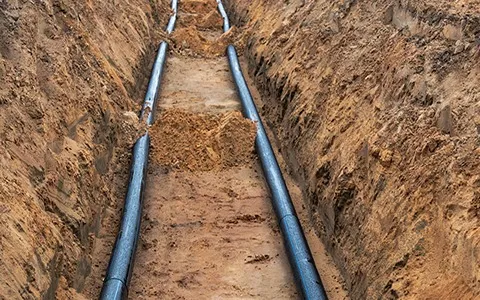There are some technics and methods regarding the installation of electrical wire and cable used for underground conditions, the following will be an explanation of the various approaches that can be taken when laying underground cables.

Underground Cable
The proper installation and attachment of fittings, such as cable end boxes, joints, branch connectors, and so on, is a significant factor in determining the degree to which an underground cable network can be relied upon for uninterrupted service.
Direct laying, the draw-in system, and the solid system are the three most common approaches to installing underground cables.
Direct laying is the most common technique.
- Direct laying: This approach to installing underground cables is quick, easy, and cost-effective, making it one of the most popular options in today's industry.
This technique for laying underground cables involves digging a trench that is approximately 0.5 meters deep and 45 centimeters wide.

Underground Cable Best
After the trench has been filled with a layer of fine sand (with a thickness of approximately 10 centimeters), the cable is then laid out on top of the sand bed.
Because the sand blocks the entry of moisture from the ground, the cable is shielded from deterioration and kept in good condition.
Following the laying of the cable in the trench, it is then covered with an additional layer of sand that is approximately ten centimeters thick.
After that, the trench is covered with bricks and other materials in order to shield the cable from the risk of being damaged by a mechanical force.
A horizontal or vertical interaxial spacing of at least 30 centimeters must be provided when more than one cable is going to be laid in the same trench.
This is done in order to reduce the effect of mutual heating and also to ensure that a fault that occurs on one cable does not damage the cable that is adjacent to it.
In order to prevent corrosion and electrolysis, the cables that are going to be laid out in this manner are required to have servings of bituminous paper and Hessian tape applied to them.
Advantages: (i) The method is both straightforward and economical.
(ii) It creates the optimal conditions for removing the heat that is produced by the cables in the system.
(iii) Because the cable is not visible and there are no disruptions from the outside, this method is both hygienic and secure.

Underground Cable Features
Disadvantages: (i) The only way to increase the load capacity is to conduct an entirely new excavation, which could end up costing just as much as the initial job.
(ii) There is a high barrier to entry when it comes to making changes to the cable network.
(iii) The price of upkeep is prohibitively expensive.
(iv) It can be difficult to pinpoint the exact location of the problem.
(v) It cannot be used in crowded areas because excavation in those kinds of places is both difficult and costly.

Underground Cable Uses
When laying cables using this method, it is done so in open areas where excavation can be carried out quickly, easily, and at a low cost.
Draw-in System: This technique for laying underground cables involves inserting conduit or duct made of glazed stone, cast iron, or concrete into the ground at suitable positions along the cable route.
Manholes are also installed at these suitable positions.
After that, the cables are pulled into place from within the manholes.
A section through a four-way underground duct line is depicted in the figure below.
Transmission cables are routed through three of the ducts, while relay protection connection and pilot wires are routed through the fourth duct.
If the depths, dips, and offsets at the point where the duct line changes direction are not made with a very long radius, then it will be difficult to pull a large cable between the manholes.

